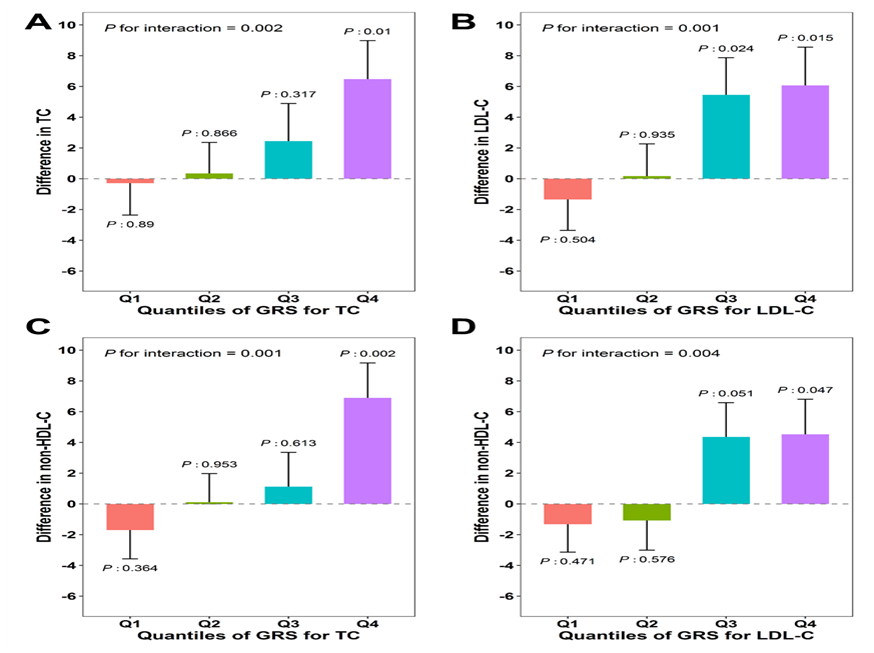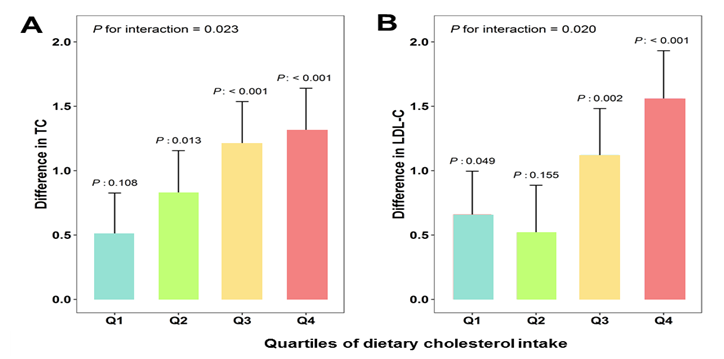Researchers Reveal Interaction Effect of Dietary Cholesterol Intake and GRSs on Plasma Cholesterol Levels
On August 12, 2020, Journal of Lipid Research online published the works of Prof. LIN Xu’s research group at Shanghai Institute of Nutrition and Health, of the Chinese Academy of Sciences, entitled "Genetic Susceptibility, Dietary Cholesterol Intake and Plasma Cholesterol Levels in a Chinese Population". This study was the first time showing the interaction effect of genetic risk score (GRS) of cholesterol and dietary cholesterol intake on blood cholesterol levels.
According to a report which pooled 102.6 million adults from 200 countries, the estimated high non-HDL-cholesterol (non-HDL-C) accounted for 3.9 million global death in 2017 and half of the death was in Asian countries. Cholesterol in human body comes from two sources, approximately 30% attributing to dietary intake and about 70% from de novo synthesis in the liver. Considering that majority studies did not show appreciable relationship between dietary cholesterol intake and circulating cholesterol levels, the latest Dietary Guidelines for Americans and Chinese removed restriction for dietary cholesterol of 300 mg/day.However, the responsiveness of blood cholesterol profile toward dietary cholesterol intake varied considerably between different populations and individuals.
Most available studies conducted in western populations only investigated effects of individual SNPs with minor influences. Though many genes involve in the complex regulation on maintaining cholesterol homeostasis, few studies have systematically evaluated collective effects of multiple genetic variants on the relationships between dietary cholesterol intake and plasma cholesterol.
Thus, by constructing genetic risk scores (GRSs) which combining multiple genetic variants, the current study aimed to examine the accumulative effects of multiple genetic variants and their interaction with dietary cholesterol intake on plasma cholesterol levels in a Chinese population.
In the current study, under supervision of Professor LIN Xu and Professor LI Huaixing, Ph.D. candidate HUO Shaofeng established GRSs for total cholesterol (TC) (GRSTC, 57 SNPs) and LDL-C (GRSLDL-C, 45 SNPs) in 2,330 participants. These participants were from the baseline of the Nutrition and Health of Aging Population in China (NHAPC) study, which aimed to investigate genetic and environmental risk factors and their interaction in metabolic diseases.
The study found that increased dietary cholesterol intake was significantly associated with elevated plasma TC, LDL-C and non-HDL-C levels. It also revealed that GRSTC and GRSLDL-C were positively associated with circulating levels of TC and LDL-C, respectively. Moreover, at given levels of dietary cholesterol, individuals with higher GRSTC or GRSLDL-C had higher plasma TC, LDL-C or non-HDL-C levels than their counterparts with lower GRSs.

Difference in plasma cholesterol levels associated with dietary cholesterol according to the quartile of GRS.
In addition, the researchers discovered that the effect of GRSTC or GRSLDL-C on plasma TC or LDL-C levels were more pronounced among those participants with higher consumption of dietary cholesterol.

Difference in plasma cholesterol levels associated with GRSs according to the quartile of dietary cholesterol intake.
(Images provided by Prof. LIN Xu's group)
Overall, this study provides important evidence regarding to personalized recommendation for dietary cholesterol intake and also demonstrated potential application of genetic risk score in precision nutrition.
This study was funded by the Major Project of the Ministry of Science and Technology of China, the Strategic Priority Research Program of Chinese Academy of Sciences and the National Natural Science Foundation of China.
Media Contact:
WANG Jin (Ms.)
Shanghai Institute of Nutrition and Health,
Chinese Academy of Sciences
Email: sibssc@sibs.ac.cn
